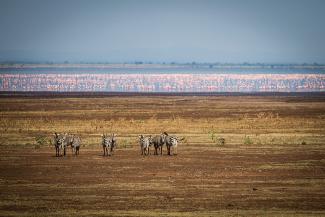Sustainability
Protecting both nature and the climate

Just about thirty years have passed since the first World Summit on Sustainable Development in Rio. Back then, the global community set out to slow down global warming and stop the loss of nature. But far too little has been achieved to date.
The situation remains dramatic: If climate change mitigation measures do not accelerate significantly, we will be heading towards an average global temperature rise of up to three degrees. The Intergovernmental Panel on Climate Change has repeatedly made urgent statements about what this means: more extreme weather events, scarce water, an uncertain food situation and probable social upheavals, to name but a few. But it also means fewer species and less biodiversity, and that we will conceivably reach ecosystem tipping points. More than 50 % of all natural ecosystems have already been destroyed; one in every eight species is at risk of extinction. Then we will lack important pollinators such as birds or insects, for example. The planet’s limits have been reached. Only resolutely setting a new course can help.
The best way to do this is by jointly addressing climate and biodiversity. They reinforce each other, both positively and negatively. When forests are cleared for farming, not only are species and ecosystem services lost, but vast amounts of climate-damaging greenhouse gases are also released. According to joint analyses by the Intergovernmental Panel on Climate Change and Intergovernmental Science-Policy Platform on Biodiversity and Ecosystem Services, plants and oceans absorb about half of the CO2 emitted by humans – and they do so naturally. This ability is reduced by global warming and changes in the oceans. It is therefore important to quickly cut emissions from fossil fuels while simultaneously preserving forests, oceans and natural habitats. Their outputs are important for drinking water, food and oxygen. But they also store carbon and slow down further warming.
Placing areas under protection is not enough to achieve these ends. Instead, our economies and our investments must become climate-neutral and ecologically friendly. The financial sector must contribute to the transformation and has recently learned a lot: EU regulation, banking supervision and the capital market are increasingly taking environmental and climate-related issues into account. KfW firmly adheres to international guidelines and systematically incorporates climate risks and the protection of biodiversity into its banking business.
However, still too little focus is placed on the connection between climate action and biodiversity conservation, both in policy and in practice. Thirty years after Rio, it is time to build a bridge – this is precisely what KfW Development Bank is striving towards with efforts that include promoting “nature-based solutions”, for example, through reforestation or the restoration of landscapes. This approach helps biodiversity while protecting the climate at the same time.
Link
Development Finance Forum 2022
www.kfw-entwicklungsbank.de/About-us/Development-Finance-Forum-2022/
Peter Hilliges and Dr Christian Lütke Wöstmann












